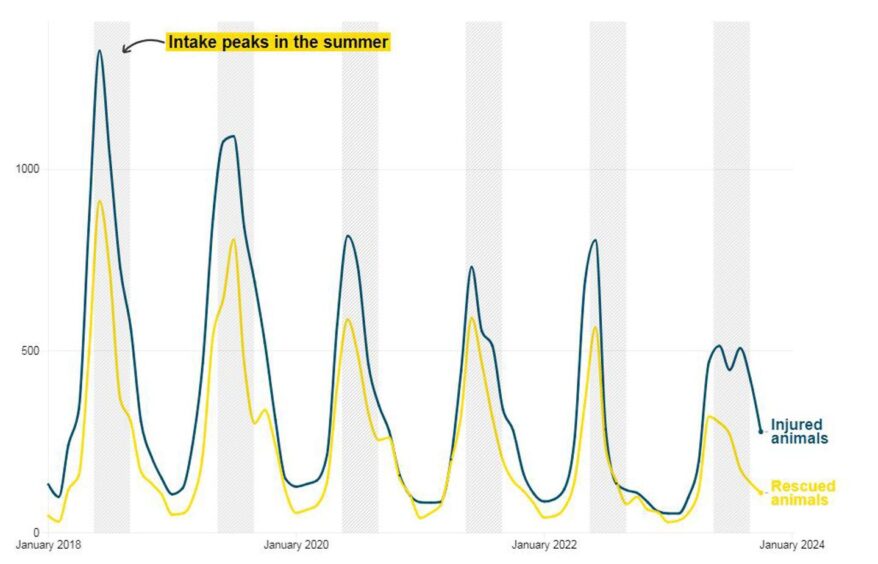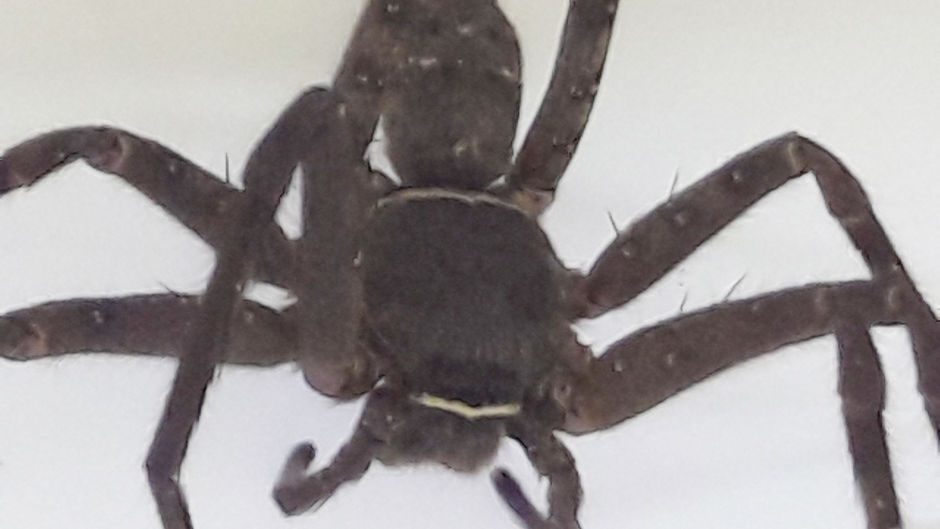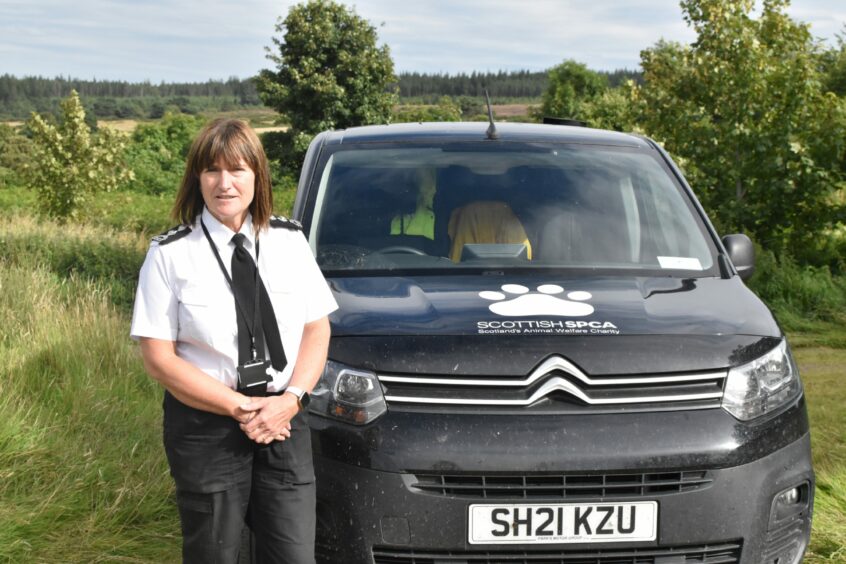
“A pet is for life, not just for Christmas”.
Or so the adage goes anyway…
As the festive season usually sees a surge in families welcoming furry friends into their homes, the Scottish SPCA granted us exclusive access to data on their work to rescue and rehome Scottish pets and wildlife.
Our analysis shows:
- The heartbreaking reasons people are giving up their pets.
- How long it takes for animals to be rehomed.
- The areas of Scotland where SSPCA callouts are occurring.
- The area of the country with the highest number of animals taken in.
Why are pets and animals rescued?
There are many reasons an animal can end up in the care of the SSPCA.
Whether someone found them injured or they were stowaways from different continents— such as the huntsman spider discovered in an Edinburgh suitcase.
The charity’s rehoming and wildlife centres are open to all.
Calls about injured and rescued animals are the most common rationale for the SSPCA to step in.
Both rescue reasons are usually associated with wildlife and see summer time peaks and lows in January or February.
Birds and hedgehogs tend to see a similar seasonal rise each year.
However, those seasonal spikes appear to be on the decline. The 2023 peak in injuries marks a 61% decrease from 2018 while call outs to rescued animals fell by 65%.
Rescue of animals commonly occurs due to investigations, calls for assistance, or taking in strays found on the streets.
All three of those reasons saw the most rescues in 2018.
Investigations have seen a rise since a drop in 2020 and 2021 but the 405 rescues in 2022 remained below the pre-pandemic years.
Some pets are simply being transferred to Animal Rescue and Rehoming Centre (ARRC) from other destinations.
In positive news, rescues in response to road traffic accidents have not passed the 100 mark since a high of 104 in 2019.
Some of the reasons are more sporadic such as home check-ups leading to rescues.
Or visits farms to make sure they are complying with animal regulations recorded as pork assurance.
How long does it take to release or rehome an animal?
The SSPCA has rehoming centres across the country, which look after animals and aim to get them into loving forever homes.
As well as cats, dogs and rabbits, they also rehome small pets like guinea pigs, gerbils and mice, ferrets, fish, horses and birds. They also rehome more exotic pets, such as snakes, bearded dragons and tarantulas.
Data from the SSPCA has shown that snakes were the trickiest species of animal to slither in to a new home.
In 2021, it took 2,054 days to find a snake in their care a home – which is over five years.
The time it takes for an animal to get rehomed varies based on factors such as medical issues, the animal’s preferences for its future home, breed, age, and the availability of animals in the centre.
In 2022, snakes had the longest average rehoming time, taking 417.7 days. Dogs followed with an average rehoming time of 224.1 days, while equines had an average of 221.8 days before finding new homes.
However, the SSPCA does not rehome all animals they bring into their centres to help. The charity releases some animals—such as bats, non-domesticated birds, other wildlife, and marine animals—back into the wild after providing them with care.
On average from 2020 to 2023, the charity releases wildlife back into its natural habitat in 50-60 days.
Amphibians and bats have had the shortest duration in care before release over the past four years, whereas carnivores and deer typically spend a longer period in centres.
Carnivores include badgers, foxes, otters, pine martins, stoats and weasels.
In 2022, the average release time for an amphibian was 24 days and 34 days for a bat, while the average release time for a carnivore was 116 days and a deer 105 days.
Carnivores also account for the largest maximum number of days kept within a centre before rehoming.
In 2022, the charity kept one of these animals for 381 days, which was the longest duration before its release. In 2020, the longest time was 532 days.
Incidents by postcode
Members of the public regularly call on the SSPCA to report incidents that they then attend. Incidents can include home checks, injured animals, and animals that need rescued.
The map below displays all the locations to which the team has responded between 2018 and November 2023.
Across Scotland, a total of 496,749 incidents have been logged to a postcode between 2018 and the beginning of November 2023.
The highest number of these were in the KY11 postcode district. This covers Dunfermline in Fife, which recorded 9,635 incidents over the almost six years.
The second highest was in the IV2 postcode, which is in Inverness. It saw 6,031 incidents logged in the time period.
The third was KY12, also Dunfermline, at 5,425.
Other locations within the top 10 areas with the most incidents reported included Alloa, Edinburgh, Falkirk, Hamilton, Perth, Kirkcaldy and Elgin.
Animals taken in by postcode
The SSPCA also tracks the number of animals taken in by postcode.
The charity takes in a range of wildlife and domesticated animals, from cats and dogs to farm animals, fish, reptiles, insects and more.
51,411 animals were taken in by the SSPCA with a postcode logged, between January 2018 and November 2023.
The highest number of animals taken in by postcode was again logged in the KY11 area.
The charity took in 1,403 animals during this period.
The second highest number of animals taken in from a single postcode was in the FK10 area, which is in Alloa. The charity took in a total of 917 animals from this location.
Other postcodes with the highest number of animals taken in include Edinburgh, Hamilton, Falkirk, Kirkcaldy, Perth and Inverness.
Where to find support
Sometimes even loving homes may no longer be able to keep their pets.
The cost-of-living crisis is seeing some families unable to afford the care of beloved animals, the SSPCA said.
But the charity is working hard to ensure pet-owners do not have to reach that point.
It is now providing pet food and supplies to over 50 foodbanks and community larders. With a further 24 on their waiting list.
There are also donation sites across the country for those who may be able to donate.
“No one should have to give up a beloved pet because they can’t afford to feed them,” said Carrie Giannelli.
She is the coordinator of the charity’s Pet Aid – the initiative that delivers animal supplies to foodbanks. This includes locations across the north and north-east, including the Aberdeen North and Highland foodbanks.
Pet Aid now supports over 400 pets and their owners each month.
Carrie said: “We know times are tough at the moment but we’d be so grateful for any donations to help pets and people who need it most.
“We can accept wet and dry dog and cat food as long as it’s unopened and in date or close to its sell by date. We can also accept unopened dog and cat treats as long as they don’t contain rawhide.
“Clean blankets, towels and hand knitted items, clean toys and items such as harnesses, leads, collars and grooming brushes would also be welcome.”
The SSPCA also offers Pet Aid gift boxes that you can purchase online and send to your nearest foodbank.
She added: “So many people are struggling to care for their animals due to financial pressures that any small donation will go a long way to helping make sure animals and people don’t suffer.”
Anyone struggling to care for their pet can call the Scottish SPCA’s animal helpline on 03000 999 999.


Conversation